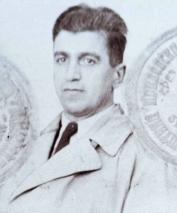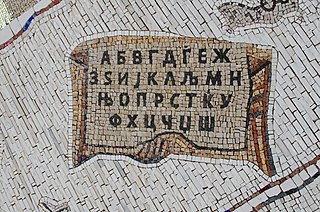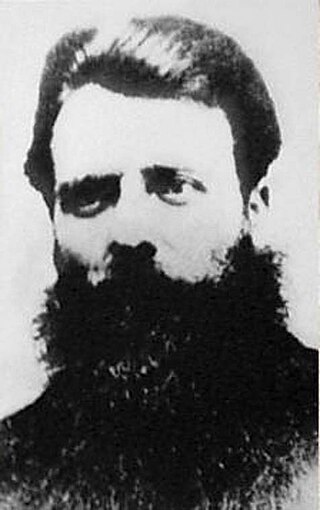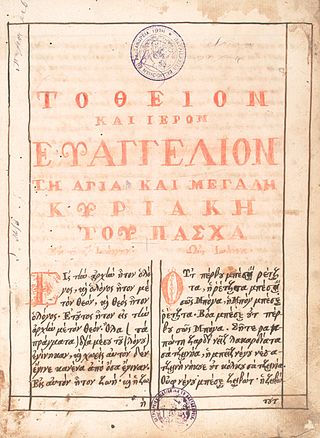James Franklin Clarke Jr. | |
|---|---|
| Born | James Franklin Clarke 1906 |
| Died | 1982 |
| Alma mater | Harvard University |
| Occupation(s) | Professor, scientist, historian |
James Franklin Clarke, Jr. was an American historian who dedicated his life to the study of the history of the activities of American Protestants and their missionaries on the Balkans, and especially contributed to the spreading of Protestantism in Bulgaria. He founded the Academic Studies on Bulgarian history in the United States.
He was born on June 5, 1906, to second-generation American missionaries in Bitola, then part of the Ottoman Empire now in North Macedonia, [1] where his father, William P. Clarke, was a missionary. He was the grandson of James Franklin Clarke Sr., who was one of the first American missionaries among the Bulgarians. During the Balkan Wars and World War I, the William Clarke family lived in Bitola. In 1919, they moved to Thessaloniki. They later moved to Switzerland and then to England, where James received a primary education. The family moved to the United States, where James graduated from high school in Boston. Clarke was said to be "totally submerged in Balkan affairs from his early youth". In 1924, Clarke enrolled at Amherst College in Massachusetts. In 1928, he earned a scholarship to Harvard University, where he received his master's degree. One year later, he began his doctoral thesis on the role of American missionaries in Bulgaria and their impact on the process of the Bulgarian National Revival. From 1931 to 1934, Clarke worked in the Bulgarian archives and libraries, visiting numerous settlements related to his research. In 1946, he was a press and culture attaché at the US Embassy in Sofia. From 1951 to 1954, he was professor of history at Indiana University, where he became the founder and director of the first Institute for Eastern European Studies. From 1954 to 1976, when he retired, he was affiliated with the University of Pittsburgh, one of the centers of Eastern European studies in the United States. After retirement, Clarke was a consultant to Duquesne University.
Clarke, as well as his missionary predecessors who were direct observers of the Balkan historical scene, adhered to the perception of the Bulgarian identity of the Macedonian Slavs. Without denying the right of this population to self-identity, he defined the concept on the "Macedonian language" as a myth, arguing with his American counterpart Horace Lunt. [2] He is the author of a collection of studies on Bulgarian history, called The pen and the sword, edited by Dennis P. Hupchick. [3]
On December 5, 1982, Clarke died at his home in Pittsburgh. [4]

Damyan Yovanov Gruev was а Bulgarian teacher, revolutionary and insurgent leader in the Ottoman regions of Macedonia and Thrace. He was one of the six founders of the Internal Macedonian Revolutionary Organization. Gruev is seen as a national hero in Bulgaria and North Macedonia but his ethnicity is disputed between both countries.

The Kometopuli dynasty was the last royal dynasty in the First Bulgarian Empire, ruling from c. 976 until the fall of Bulgaria under Byzantine rule in 1018. The most notable member of the dynasty, Tsar Samuel, is famous for successfully resisting Byzantine conquest for more than 40 years. Sometimes the realm of the Cometopuli is called Western Bulgarian Kingdom or Western Bulgarian Empire.

The Bitola inscription is a stone inscription from the First Bulgarian Empire written in the Old Church Slavonic language in the Cyrillic alphabet. Currently, it is located at the Institute and Museum of Bitola, North Macedonia, among the permanent exhibitions as a significant epigraphic monument, described as "a marble slab with Cyrillic letters of Jovan Vladislav from 1015/17". In the final stages of the Byzantine conquest of Bulgaria Ivan Vladislav was able to renovate and strengthen his last fortification, commemorating his work with this elaborate inscription. The inscription found in 1956 in SR Macedonia, provided strong arguments supporting the Bulgarian character of Samuil's state, disputed by the Yugoslav scholars.

The existence and distinctiveness of the Macedonian language is disputed in Bulgaria and the name of the language was disputed by Greece. By signing the Prespa Agreement, Greece accepted the name "Macedonian language" in reference to the official language of North Macedonia.
The history of the Macedonian language refers to the developmental periods of current-day Macedonian, an Eastern South Slavic language spoken on the territory of North Macedonia. The Macedonian language developed during the Middle Ages from the Old Church Slavonic, the common language spoken by Slavic people.

Kiril Peychinovich or Kiril Pejčinović was a Bulgarian cleric, writer and enlightener, one of the first supporters of the use of modern Bulgarian, and one of the early figures of the Bulgarian National Revival.

The history of the Jews in North Macedonia stretches back two thousand years, beginning during Roman antiquity, when Jews first arrived in the region. Today, following the Holocaust and emigration, especially to Israel, around 200 Jews remain in North Macedonia, mostly in the capital, Skopje and a few in Štip and Bitola.

Metodi Tasev Shatorov - Sharlo was a Bulgarian Communist Party activist and also the temporary leader of the Regional Committee of Communists in Macedonia in 1940-1941. Like most left-wing politicians from Macedonia, during the 1930s he adopted the Resolution of the Comintern on the Macedonian question, about the recognition of a distinct Macedonian national identity. However, such Macedonian communist functionaries, originating from the Bulgarian Communist Party (BCP) and Internal Macedonian Revolutionary Organization (United), maintained pro-Bulgarian sentiments.

Andon Kalchev was a Bulgarian army officer, one of the leaders of the Bulgarian-backed Ohrana, a paramilitary formation of Bulgarians in Greek Macedonia during World War II Axis occupation. He was active outside the Bulgarian occupied area of Macedonia, under the tolerance of the Italian and German authorities which used him in their fights with rival Greek EAM-ELAS and Yugoslav Communist resistance groups. Because of his collaborationist activity, he was sentenced to death by Greek military tribunal, and was executed by firing squad on 27 August 1948.

Yordan Hadzhikonstantinov - Dzhinot, was a Bulgarian teacher and author, an important figure of the Bulgarian National Revival during the 19th century.
Theodosius of Sinai, was a Bulgarian priest, writer and printer. He founded the first Bulgarian printing-house in Thessaloniki.
Mercia MacDermott was an English writer and historian. She was known for her books on Bulgarian history.

Macedonian studies is an academic discipline within Slavic studies that focuses on the comprehensive study of the Macedonian language, literature, history, and culture. As part of Slavic studies, it falls within the subgroup of South Slavic languages and cultures. Apart from North Macedonia, Macedonian Studies is also taught at universities worldwide, including in Albania, Canada, Poland, the United States, and post-Yugoslav countries. A linguist who studies Macedonian as part of the field is called a Macedonist.

Vasil Kostov Glavinov was a Bulgarian left-wing politician from Ottoman Macedonia, and an activist of the Bulgarian workers' movement.

The resolution of the Comintern of January 11, 1934, was an official political document, in which for the first time, an authoritative international organization has recognized the existence of a separate Macedonian nation and Macedonian language.

The royal Tetraevangelia of Ivan Alexander is an illuminated manuscript Gospel Book in middle Bulgarian, prepared and illustrated in 1355–1356 for Tsar Ivan Alexander of the Second Bulgarian Empire. The manuscript is regarded as one of the most important manuscripts of medieval Bulgarian culture. The manuscript, now in the British Library, contains the text of the Four Gospels illustrated with 366 miniatures and consists of 286 parchment folios, 33 by 24.3 cm in size.

The history of Bible translations into Macedonian is connected in its early years with the history of Bible translations into Bulgarian. After the codification of Macedonian in 1945, in 1952 a liturgical edition of the four Gospels was printed as the first official translation into standard Macedonian.
The Eastern South Slavic dialects form the eastern subgroup of the South Slavic languages. They are spoken mostly in Bulgaria and North Macedonia, and adjacent areas in the neighbouring countries. They form the so-called Balkan Slavic linguistic area, which encompasses the southeastern part of the dialect continuum of South Slavic.
Dennis P. Hupchick is Professor of History, Emeritus at Wilkes University, Pennsylvania.

Stemmatografia, known by its full name Stemmatographia sive Armorum Illyricorum delineatio, descriptio et restitutio is a heraldic essay written and illustrated by Pavao Ritter Vitezović, and originally published in 1701.